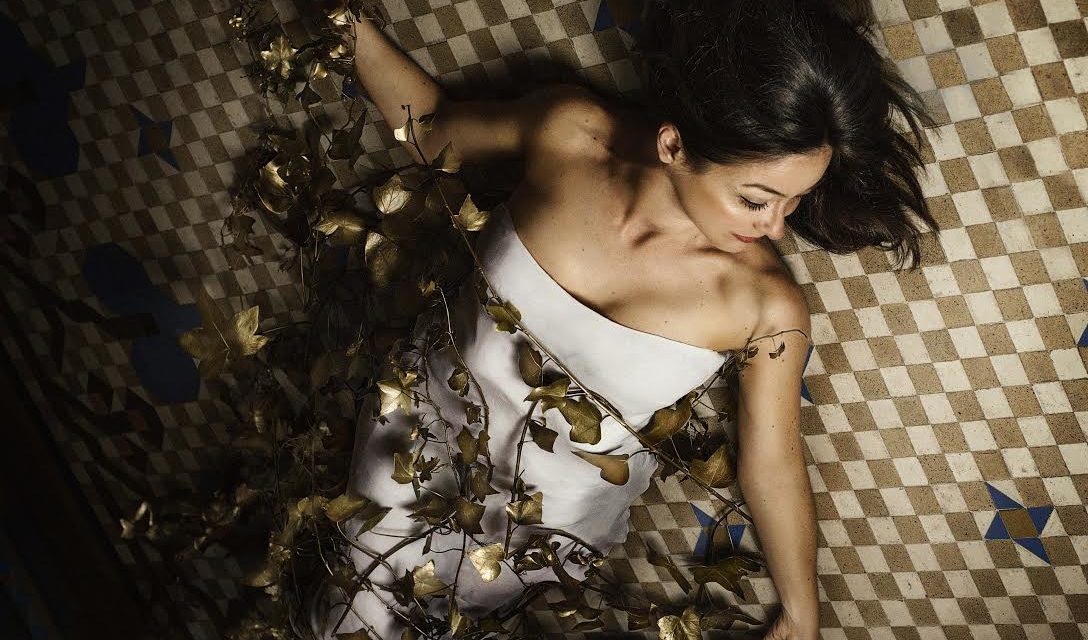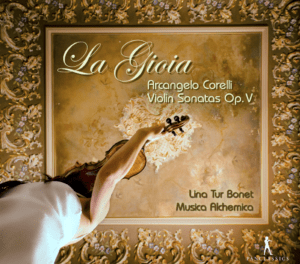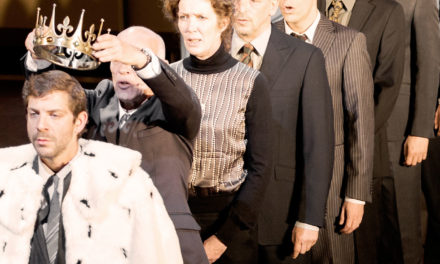“Any cultural event is a heroic feat in our society.”
Lina Tur Bonet, the Spanish violinist of worldwide fame is known for her innovativeness and her fresh approach to classics. Last May, she was part of the presentation Made In Murcia that took place at the Cervantes Theatre in London. An event of this type is quite unique: in this new versatile space dedicated to Spanish culture away from Spain, classical music and theatricality communed to show they have more in common than what people expect. Lina underlines the importance of events like Made In Murcia: “We are living in a time of economic interests and politics, and I believe that art, music, theatre are absolutely universal. They’re timeless and speak from any human being to any human being, directly to the heart. They’re spiritual and emotional food. And we need that like we need water. In these moments more than ever.”
Made In Murcia was structured as concert-conference with the aim of presenting in London some of the most relevant productions of this region in Spain. It began with the live presentation of Corelli’s “La Gioia,” Lina’s new album, performed by the violinist accompanied by Daniel Espasa. This project has been of special significance for Lina, who put her soul into the CD when she developed the ornaments for Corelli’s sonatas.
“I’ve had to create improvisations for the twelve sonatas. So in those cases we were truly creating something new, but based on ancient music. I did the research (I went to Italy, I studied past ornamentation) to keep the style of the times, but it was also something completely new.
At first you wonder, who am I to dare improvise on the music of someone that big. I’m only Lina. But then you start seeing that in the eighteenth century alone there are more than 50 editions of Corelli’s sonatas, some of them with ornamentation that were created by different individuals, violinists. Each of them was adding something from their being. And this practic
CD cover of La Gioia by Zabet photos (provided by the artist)
e was completely legitimate, widespread. So we think that nowadays we are doing very modern things, but this is a very old practice. In face of this, all the solemnity that surrounds certain types of composers is misunderstood. It wasn’t like that before.”
One of the things Lina Tur Bonet is incredibly passionate about and famous for is opening the emotional lock to classical music, making it accessible for all audiences.
“We need to change is its presentation. The type of concerts we have right now in music halls is not even the one that used to exist in the Baroque era. In Baroque times, people would clap, cheer during solos. The nineteenth century started separating stage from audience and created a distance that can help a certain type of music but that has led to losing the meaning of the relationship. It’s true that when we play, people can’t be chatting because our instruments are not amplified like in a jazz concert. But within those rules, you can play with the audience. For instance, you can start in the back of the room, where people can hear it but can’t see you. Doing these things is possible and quite beautiful, yet the most important aspect is the spirit you put into the performance. You are communicating a different idea, a different spirit: ok, I’m playing music that is three hundred years old, but I am playing it as a person from today. We are connecting spaces and times.”
Lina believes that it is up to musicians to change the fixedness that has been associated with classical music, to show the person behind the artist playing the violin. The event in the intimate, human space of the Cervantes Theatre helped melt away the perceived distance between the performers and the audience. “The proximity with the audience encourages dialogue,” Lina explains. After the performance of La Gioia, there was a discussion with the artists involved in which people could candidly ask about the project and classical music to the artist. “People were eager to ask us things. We talked a lot about improvisation, for instance. It seems like it’s a taboo topic for classical music, but for this CD we have really curated instrumentation and improvisation. So people wanted to know and it led to an incredible dialogue. That was key to the success of the event: people could ask us questions and get to know things that they didn’t know about but we love explaining.”
The last part of Made In Murcia consisted of the presentation of La Follía, a video result of the collaboration between Lina Tur Bonet and the visual artist Angel Haro. The project was developed at Centro Párraga in Murcia after the two artists met. Lina had seen an exhibition of Haro’s work at Madrid and became an admirer of his work. When they met at a concert of hers in Murcia, the idea of working together arose and thus this project was born. This is not the first time Lina has worked with artists in other media. She reflects, “I’m a violinist and that’s very time-consuming but I’ve always wanted to do many other things. So I use music as a way to find other artists because I can’t do it all.” Moreover, she believes that through collaboration with other artists, new perspectives arise that can help classical music become accessible for audiences. Other media offers fresh perspectives on the music that Lina has seen work on the public in a moving way, “these projects have been an endless source of joy. People express gratitude and ask for more!”
Apart from the video work with Angel Haro, Lina Tur crossed many other disciplines. For the La Gioia, for instance, Lina sought to work with a goldsmith to include a jewel piece with the CD (“gioia” means both jewel and happiness in Italian). She explains how this idea was born “Corelli has such a fresh, joyful music that is like a jewel, I started thinking that every ornamentation is actually a jewel. So I spoke to a goldsmith and he made a jewel that we could include in the CD: it’s made of gold threads, which represent ideas. You have gold, which is Corelli-like—very Roman; you have the ideas; you have the jewel.” She has also worked with dancers, painters, shadow artistry and was recently in Japan on a retreat with a composer (José María Sánchez Verdú) and a No theatre performer. In the future, Lina hopes to explore more improvisational theatre and clowning as a format.
While Lina Tur Bonet’s artistry has not yet led to the creation of a theatre piece, in the way that, for instance, the Scottish violinist Mairi Campbell did last year for the Edinburgh Fringe, her perspective on classical music shares much ground with theatre. Not only does she consider Baroque music essentially theatrical in its dramatic presentation and rich orchestration, but also the role of the violinist she believes can be understood in terms of that of an actor. “It’s like Shakespeare,” Lina ponders, “music, a music sheet is like a letter left by someone who died a long time ago. It’s not like a painting that already exists. Musicians have to play it to make it alive—just like actors.” In the delivery of the message of the music, Lina resorts to rhetoric: “For me, music is telling a story; it’s rhetoric. When you play music, you are playing with time. You are making time pass in a different way for the people present. You’re manipulating emotions, time and ideas. You are creating new worlds. That’s why it’s a creative art.”
As a storyteller and music performer, Lina Tur Bonet is wary of fusions. She treasures the letters that old composer have left us just as they are. However, she believes that without changing a note, a very well known music sheet can sound fresh and relevant just by the power of performance. “Classical music is very reproduced, so you’re never starting from scratch, but when you take it upon yourself to play a piece, even if you have played it thousands of times, you play it as if it were the first time. You feel it. This is so powerful; it makes the event alive. It’s like saying, ‘I love you, I love you, I love you, I love you’ repeatedly versus when you just saying, ‘I love you’ because you feel it in that moment. If you repeat something a lot it can become a mantra, so it’s important not to lose that freshness.” By juxtaposing Lina’s ideas about the performance of music to theatre performance, the importance of rhetoric and emotional connection can unlock important keys to the rejuvenation of the theatre classics.
Lina Tur Bonet, a champion of tradition and a fearless innovator does not think these two aspects of her work are necessarily opposed. “Maintaining tradition is so important to me. Corelli, Bach, Beethoven… they are too good to not be worshipped every day. But at the same time, we must continue. We have to learn from them in order to keep the dialogue. They have to be remembered for the audiences. They can’t be left to die. Every generation carries a torch to be kept at full flame. It’s just so important to keep playing the classics. But there is also a way to innovate; there is always a way to do both things without harming one. And I think that’s where I’m very strong: I can combine both things. I can preserve classics as they are meant to be while showing how universal and current they can be—just like they were 500 years ago.” In her work that welcomes artists from different areas and different cultures to empower old messages from the past, there is hope to be found for our times and for the future.
This post was written by the author in their personal capacity.The opinions expressed in this article are the author’s own and do not reflect the view of The Theatre Times, their staff or collaborators.
This post was written by Aida Rocci Ruiz.
The views expressed here belong to the author and do not necessarily reflect our views and opinions.



















